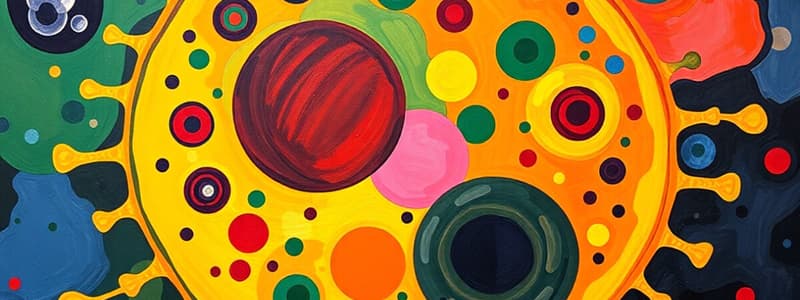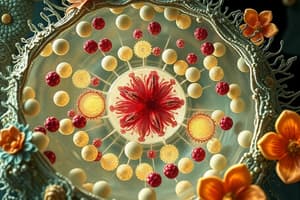Podcast
Questions and Answers
Which of the following structures is specifically found in plant cells but not in animal cells?
Which of the following structures is specifically found in plant cells but not in animal cells?
- Chloroplasts (correct)
- Mitochondria
- Ribosomes
- Cell membrane
Animal cells have a cell wall.
Animal cells have a cell wall.
False (B)
What is the primary function of ribosomes in a cell?
What is the primary function of ribosomes in a cell?
Protein synthesis
The __________ is the powerhouse of the cell, responsible for ATP production.
The __________ is the powerhouse of the cell, responsible for ATP production.
Which of the following statements about the cell wall is TRUE?
Which of the following statements about the cell wall is TRUE?
Match the following types of cells with their characteristics:
Match the following types of cells with their characteristics:
Photosynthesis occurs in the __________ of plant cells.
Photosynthesis occurs in the __________ of plant cells.
Prokaryotic cells contain membrane-bound organelles.
Prokaryotic cells contain membrane-bound organelles.
Which of these is NOT a type of specialized cell?
Which of these is NOT a type of specialized cell?
Embryonic stem cells are multipotent, meaning they can develop into only a limited range of cell types.
Embryonic stem cells are multipotent, meaning they can develop into only a limited range of cell types.
What is the process called where DNA duplicates itself prior to cell division?
What is the process called where DNA duplicates itself prior to cell division?
During mitosis, ______ pull chromosomes to opposite sides of the cell.
During mitosis, ______ pull chromosomes to opposite sides of the cell.
Match the following types of cell transport with their descriptions:
Match the following types of cell transport with their descriptions:
Which of the following components is found in both animal and plant cells?
Which of the following components is found in both animal and plant cells?
Prokaryotic cells contain mitochondria.
Prokaryotic cells contain mitochondria.
What process do chloroplasts in plant cells primarily facilitate?
What process do chloroplasts in plant cells primarily facilitate?
The __________ is the rigid structure found in plant cells that provides support.
The __________ is the rigid structure found in plant cells that provides support.
Flashcards
Eukaryotic Cells
Eukaryotic Cells
Both animal and plant cells are eukaryotic cells, meaning they have a membrane-bound nucleus and other organelles.
Cell Membrane
Cell Membrane
The cell membrane is a thin, flexible barrier that controls what enters and leaves the cell.
Mitochondria
Mitochondria
Mitochondria are the powerhouses of the cell, where energy is produced through cellular respiration.
Ribosomes
Ribosomes
Signup and view all the flashcards
Chloroplasts
Chloroplasts
Signup and view all the flashcards
Cell Wall
Cell Wall
Signup and view all the flashcards
Prokaryotic Cells
Prokaryotic Cells
Signup and view all the flashcards
Plasmids
Plasmids
Signup and view all the flashcards
Cell Specialization
Cell Specialization
Signup and view all the flashcards
Stem Cells
Stem Cells
Signup and view all the flashcards
Embryonic Stem Cells
Embryonic Stem Cells
Signup and view all the flashcards
Adult Stem Cells
Adult Stem Cells
Signup and view all the flashcards
Mitosis
Mitosis
Signup and view all the flashcards
Interphase
Interphase
Signup and view all the flashcards
Mitosis
Mitosis
Signup and view all the flashcards
Passive Transport
Passive Transport
Signup and view all the flashcards
Diffusion
Diffusion
Signup and view all the flashcards
Active Transport
Active Transport
Signup and view all the flashcards
What is cytoplasm?
What is cytoplasm?
Signup and view all the flashcards
What is the cell membrane's function?
What is the cell membrane's function?
Signup and view all the flashcards
What is the function of ribosomes?
What is the function of ribosomes?
Signup and view all the flashcards
What is the function of the nucleus?
What is the function of the nucleus?
Signup and view all the flashcards
What is the function of mitochondria?
What is the function of mitochondria?
Signup and view all the flashcards
What are stem cells?
What are stem cells?
Signup and view all the flashcards
What are embryonic stem cells?
What are embryonic stem cells?
Signup and view all the flashcards
What are adult stem cells?
What are adult stem cells?
Signup and view all the flashcards
What is mitosis?
What is mitosis?
Signup and view all the flashcards
What is diffusion?
What is diffusion?
Signup and view all the flashcards
What is osmosis?
What is osmosis?
Signup and view all the flashcards
What is active transport?
What is active transport?
Signup and view all the flashcards
What are the factors affecting cell transport?
What are the factors affecting cell transport?
Signup and view all the flashcards
Study Notes
Animal and Plant Cells
- Animal and plant cells are both eukaryotic cells.
- Both animal and plant cells contain a cell membrane, mitochondria, ribosomes, cytoplasm, and a nucleus.
- Plant cells uniquely have a permanent vacuole, chloroplasts, and a cell wall. Plant cell walls are made of cellulose.
- The vacuole in plant cells stores water and maintains cell shape.
- Chloroplasts are the sites of photosynthesis, converting light energy to chemical energy.
- The cell wall provides structural support and rigidity to plant cells.
- Exam questions commonly assess similarities and differences between animal and plant cells.
Subcellular Structures
- Each subcellular structure plays a specific role in the cell.
- Cell Membrane: Controls the movement of substances in and out of the cell.
- Cytoplasm: A gel-like substance where chemical reactions take place.
- Nucleus: Contains the cell's DNA and controls cellular activities.
- Mitochondria: The sites of aerobic respiration.
- Ribosomes: Sites of protein synthesis, translating mRNA into proteins.
- Permanent Vacuole: A large, fluid-filled sac in plant cells, storing water, nutrients, and waste, maintaining turgor pressure.
- Chloroplasts: Sites of photosynthesis in plant cells, converting light energy to chemical energy. They contain chlorophyll.
- Cell Wall: A rigid structure that supports and protects the plant cell, made of cellulose.
Bacterial Cells
- Bacterial cells are prokaryotic cells, much smaller than eukaryotic cells.
- Prokaryotic cells lack a nucleus and membrane-bound organelles (mitochondria, ribosomes, chloroplasts, vacuoles).
- They contain a single DNA loop and plasmids in their cytoplasm.
- Plasmids are small, circular DNA molecules that replicate independently carrying genes (antibiotic resistance, etc.).
- Prokaryotes are single-celled organisms.
Microscopes
- Light and electron microscopes are the two main types.
- Light microscopes, common in schools, use visible light to illuminate specimens.
- Electron microscopes use electron beams for highly magnified and detailed images.
- Electron microscopes have greater magnification and resolution, enabling observation of smaller structures in cells.
- Electron microscopes require dead specimens. Light microscopes can use living or non-living specimens.
- I (image size) = M (magnification) × A (actual size)
Cell Specialization and Stem Cells
- Cell specialization is the process of cell differentiation for specific functions.
- Examples include nerve cells (neurons), fat cells (adipocytes), muscle cells (myocytes), brain cells (neurons), root hair cells, red blood cells, and sperm cells.
- Stem cells are undifferentiated cells capable of developing into various specialized cells.
- Embryonic stem cells: Totipotent – can become any cell type.
- Adult stem cells: Multipotent – can become most cell types.
- Stem cells are crucial in research and potential treatments for diseases.
Mitosis and the Cell Cycle
- Mitosis produces two genetically identical daughter cells from one parent cell.
- The cell cycle has two main phases: interphase and mitosis.
- Interphase: Cell growth and DNA duplication.
- Mitosis:
- DNA duplication
- Chromosome alignment
- Chromosome separation to opposite poles
- Nuclei reformation at each side of cell
- Cell membrane splitting, creating two daughter cells.
Cell Transport
- Cell transport moves substances across the cell membrane.
- Passive Transport (no energy):
- Diffusion: Movement from high to low concentration (e.g., oxygen from lungs to blood).
- Osmosis: Water diffusion across a selectively permeable membrane (e.g., water absorption in the large intestine).
- Active Transport (energy required): Movement from low to high concentration (e.g., nutrient uptake by root hair cells).
Factors Affecting Cell Transport
- Surface area: Larger surface area speeds transport.
- Temperature: Higher temperature increases molecule speed, thus increasing transport rate.
- Diffusion pathway: Shorter pathway leads to faster transport.
- Blood supply: Constant concentration gradient enhances transport.
- Concentration gradient: Steep concentration gradient leads to faster transport.
- Steepness of concentration gradient: A greater difference in concentration speeds up transport.
Studying That Suits You
Use AI to generate personalized quizzes and flashcards to suit your learning preferences.




